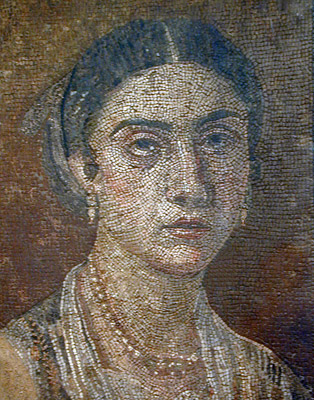 Mosaic portrait, Pompeii, 1st Century CE
Mosaic portrait, Pompeii, 1st Century CE
 Mosaic portrait, Pompeii, 1st Century CE
Mosaic portrait, Pompeii, 1st Century CE
Who are the women who read Ovid's Ars Amatoria? Did they read his handbook on the art of courtship and seduction for entertainment or, trusting Ovid's boast ego sum praeceptor Amoris (1.17), for instruction? Did they read the first two books offering males strategies for success with women, or only the third, for its tutelage on using their bodies to attract men? At the beginning of the Ars, Ovid warns those who wear priestly and matronal dress to keep their distance as he sings songs of love, blameless though they be (1.31-4):
Este procul, vittae tenues, insigne pudoris,
Quaeque tegis medios, instita longa, pedes.
Nos venerem tutam concessaque furta canemus,
Inque meo nullum carmine crimen erit.
The poet identifies his female audience at the end of the second book as tenerae puellae who have asked him to instruct them: ecce, rogant tenerae, sibi dem praecepta, puellae (2.745). Again being deliberately ambiguous, Ovid characterizes his female readership as those who are permitted and who permit themselves to follow his precepts: quas pudor et leges et sua iura sinunt (3. 58). The question remains. Who are these educated and sophisticated puellae who have the freedom and desire to learn how to beguile men – are they the demimonde? unmarried girls seeking husbands? women tempted to imitate the puellae of elegy? Or is Ovid’s real audience not at all the hapless puellae to whom he offers humorous and witty precepts? Has he, in fact, written the third book as well for males, allowing them to peer into the world of women and to laugh at women's efforts to play the game of love? In this book women are advised how to dress, how to behave, what topics to talk about, and what activities to pursue in order to help them understand what men find attractive in a woman. In the passage below, Ovid advises women how best to laugh, to speak, and to walk so as not to drive men away, encouraging them to make themselves appealing objects for pursuit, but not to actively engage in pursuit themselves. Despite the lightheartedness of its subject, the Ars follows the conventions of didactic poetry as they appear in Vergil’s Georgica and Lucretius’ De Rerum Natura. However, instead of hexameter, the meter of didactic poetry, Ovid composed his work in elegiac couplet, matching his meter to the themes of love and gender relations which he shares with the love poems of Tibullus and Propertius.
281 Quis credat? discunt etiam ridere puellae,
quaeritur aque illis hac quoque parte decor.
Sint modici rictus, parvaeque utrimque lacunae,
et summos dentes ima labella tegant.
285 Nec sua perpetuo contendant ilia risu,
sed leve nescioquid femineumque sonent.
Est quae perverso distorqueat ora cachinno;
risu concussa est altera, flere putes.
Illa sonat raucum quiddam atque inamabile ridet,
290 ut rudit a scabra turpis asella mola.
Quo non ars penetrat? discunt lacrimare decenter,
quoque volunt plorant tempore, quoque modo.
Quid cum legitima fraudatur littera voce
blaesaque fit iusso lingua coacta sono?
295 In vitio decor est: quaedam male reddere verba
discunt posse minus quam potuere, loqui.
Omnibus his, quoniam prosunt, impendite curam:
discite femineo corpora ferre gradu.
Est et in incessu pars non contempta decoris;
300 allicit ignotos ille fugatque viros.
Haec movet arte latus, tunicisque fluentibus auras
accipit, expensos fertque superba pedes.
Illa velut coniunx Umbri rubicunda mariti
ambulat, ingentes varica fertque gradus.
305 Sed sit, ut in multis, modus hic quoque: rusticus alter
motus, concesso mollior alter erit.
Pars umeri tamen ima tui, pars summa lacerti
nuda sit, a laeva conspicienda manu.
Click on the underlined words for translation aids and commentary, which will appear in a small window. Click on the icon link
![]() to the right of the
poem for related images and information.
to the right of the
poem for related images and information.